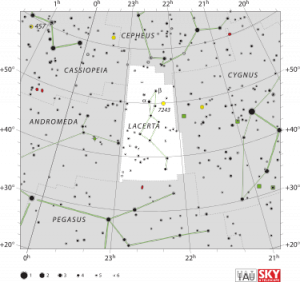Lacerta: Difference between revisions
No edit summary |
No edit summary |
||
| (4 intermediate revisions by the same user not shown) | |||
| Line 5: | Line 5: | ||
Lacerta is typical of Milky Way constellations: no bright galaxies, nor globular clusters, but instead open clusters, for example NGC 7243, the faint planetary nebulaIC 5217 and quite a few double stars. It also contains the prototypic blazar BL Lacertae. Lacerta contains no Messier objects. | Lacerta is typical of Milky Way constellations: no bright galaxies, nor globular clusters, but instead open clusters, for example NGC 7243, the faint planetary nebulaIC 5217 and quite a few double stars. It also contains the prototypic blazar BL Lacertae. Lacerta contains no Messier objects. | ||
Although not included in ancient star charts of Europe and the Near East, the stars of Lacerta, along with some in the eastern portion of Cygnus, were coincidentally combined by early Chinese astronomers into their "Flying Serpent." Similarly, the Chumash people of California call this part of the sky 'Lizard' and include it in multiple stories.<ref[http://en.wikipedia.org/wiki/Lacerta Lacerta]</ref> | Although not included in ancient star charts of Europe and the Near East, the stars of Lacerta, along with some in the eastern portion of Cygnus, were coincidentally combined by early Chinese astronomers into their "Flying Serpent." Similarly, the Chumash people of California call this part of the sky 'Lizard' and include it in multiple stories.<ref>[http://en.wikipedia.org/wiki/Lacerta Lacerta]</ref> | ||
==HGS Session References== | ==HGS Session References== | ||
HGS Sessions - Clearing [[Hyperspace Phantom Matrix]] - 3/12/2015 <ref>[ | HGS Sessions - Clearing [[Hyperspace Phantom Matrix]] - 3/12/2015 <ref>HGS Session</ref>HGS Sessions - Clearing [[Tara, Gaia, Cradle of Lyra]]- 3/12/2015 <ref>HGS Session</ref>HGS Sessions - Clearing [[Macau Island, China]] - 3/21/2015 <ref> HGS Session</ref>HGS Sessions - Clearing [[Dorado, Leo Minor, Musca, Perseus constellations]] - 3/23/2015 <ref> HGS Session</ref>HGS Sessions - Clearing [[San Francisco Golden Gate Bridge, 55 Reversal Grid]] - 3/31/2015 <ref>HGS Session</ref> | ||
==References== | ==References== | ||
Latest revision as of 00:45, 14 September 2017
Lacerta is one of the 88 modern constellations defined by the International Astronomical Union. Its name is Latin for lizard. A small, faint constellation, it was created in 1687 by the astronomer Johannes Hevelius. Its brightest stars form a "W" shape similar to that of Cassiopeia, and it is thus sometimes referred to as 'Little Cassiopeia'. It is located between Cygnus, Cassiopeia and Andromeda on the northern celestial sphere. The northern part lies on the Milky Way.
Lacerta is typical of Milky Way constellations: no bright galaxies, nor globular clusters, but instead open clusters, for example NGC 7243, the faint planetary nebulaIC 5217 and quite a few double stars. It also contains the prototypic blazar BL Lacertae. Lacerta contains no Messier objects.
Although not included in ancient star charts of Europe and the Near East, the stars of Lacerta, along with some in the eastern portion of Cygnus, were coincidentally combined by early Chinese astronomers into their "Flying Serpent." Similarly, the Chumash people of California call this part of the sky 'Lizard' and include it in multiple stories.[1]
HGS Session References
HGS Sessions - Clearing Hyperspace Phantom Matrix - 3/12/2015 [2]HGS Sessions - Clearing Tara, Gaia, Cradle of Lyra- 3/12/2015 [3]HGS Sessions - Clearing Macau Island, China - 3/21/2015 [4]HGS Sessions - Clearing Dorado, Leo Minor, Musca, Perseus constellations - 3/23/2015 [5]HGS Sessions - Clearing San Francisco Golden Gate Bridge, 55 Reversal Grid - 3/31/2015 [6]
References
Found in HGS Manual on Page 108
Found in HGS Manual on Page 115


